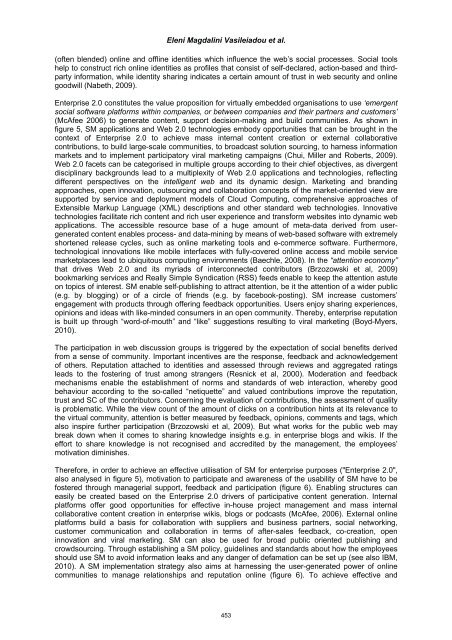Proceedings of the 3rd European Conference on Intellectual Capital
Proceedings of the 3rd European Conference on Intellectual Capital
Proceedings of the 3rd European Conference on Intellectual Capital
You also want an ePaper? Increase the reach of your titles
YUMPU automatically turns print PDFs into web optimized ePapers that Google loves.
Eleni Magdalini Vasileiadou et al.<br />
(<str<strong>on</strong>g>of</str<strong>on</strong>g>ten blended) <strong>on</strong>line and <str<strong>on</strong>g>of</str<strong>on</strong>g>fline identities which influence <str<strong>on</strong>g>the</str<strong>on</strong>g> web’s social processes. Social tools<br />
help to c<strong>on</strong>struct rich <strong>on</strong>line identities as pr<str<strong>on</strong>g>of</str<strong>on</strong>g>iles that c<strong>on</strong>sist <str<strong>on</strong>g>of</str<strong>on</strong>g> self-declared, acti<strong>on</strong>-based and thirdparty<br />
informati<strong>on</strong>, while identity sharing indicates a certain amount <str<strong>on</strong>g>of</str<strong>on</strong>g> trust in web security and <strong>on</strong>line<br />
goodwill (Nabeth, 2009).<br />
Enterprise 2.0 c<strong>on</strong>stitutes <str<strong>on</strong>g>the</str<strong>on</strong>g> value propositi<strong>on</strong> for virtually embedded organisati<strong>on</strong>s to use ‘emergent<br />
social s<str<strong>on</strong>g>of</str<strong>on</strong>g>tware platforms within companies, or between companies and <str<strong>on</strong>g>the</str<strong>on</strong>g>ir partners and customers’<br />
(McAfee 2006) to generate c<strong>on</strong>tent, support decisi<strong>on</strong>-making and build communities. As shown in<br />
figure 5, SM applicati<strong>on</strong>s and Web 2.0 technologies embody opportunities that can be brought in <str<strong>on</strong>g>the</str<strong>on</strong>g><br />
c<strong>on</strong>text <str<strong>on</strong>g>of</str<strong>on</strong>g> Enterprise 2.0 to achieve mass internal c<strong>on</strong>tent creati<strong>on</strong> or external collaborative<br />
c<strong>on</strong>tributi<strong>on</strong>s, to build large-scale communities, to broadcast soluti<strong>on</strong> sourcing, to harness informati<strong>on</strong><br />
markets and to implement participatory viral marketing campaigns (Chui, Miller and Roberts, 2009).<br />
Web 2.0 facets can be categorised in multiple groups according to <str<strong>on</strong>g>the</str<strong>on</strong>g>ir chief objectives, as divergent<br />
disciplinary backgrounds lead to a multiplexity <str<strong>on</strong>g>of</str<strong>on</strong>g> Web 2.0 applicati<strong>on</strong>s and technologies, reflecting<br />
different perspectives <strong>on</strong> <str<strong>on</strong>g>the</str<strong>on</strong>g> intelligent web and its dynamic design. Marketing and branding<br />
approaches, open innovati<strong>on</strong>, outsourcing and collaborati<strong>on</strong> c<strong>on</strong>cepts <str<strong>on</strong>g>of</str<strong>on</strong>g> <str<strong>on</strong>g>the</str<strong>on</strong>g> market-oriented view are<br />
supported by service and deployment models <str<strong>on</strong>g>of</str<strong>on</strong>g> Cloud Computing, comprehensive approaches <str<strong>on</strong>g>of</str<strong>on</strong>g><br />
Extensible Markup Language (XML) descripti<strong>on</strong>s and o<str<strong>on</strong>g>the</str<strong>on</strong>g>r standard web technologies. Innovative<br />
technologies facilitate rich c<strong>on</strong>tent and rich user experience and transform websites into dynamic web<br />
applicati<strong>on</strong>s. The accessible resource base <str<strong>on</strong>g>of</str<strong>on</strong>g> a huge amount <str<strong>on</strong>g>of</str<strong>on</strong>g> meta-data derived from usergenerated<br />
c<strong>on</strong>tent enables process- and data-mining by means <str<strong>on</strong>g>of</str<strong>on</strong>g> web-based s<str<strong>on</strong>g>of</str<strong>on</strong>g>tware with extremely<br />
shortened release cycles, such as <strong>on</strong>line marketing tools and e-commerce s<str<strong>on</strong>g>of</str<strong>on</strong>g>tware. Fur<str<strong>on</strong>g>the</str<strong>on</strong>g>rmore,<br />
technological innovati<strong>on</strong>s like mobile interfaces with fully-covered <strong>on</strong>line access and mobile service<br />
marketplaces lead to ubiquitous computing envir<strong>on</strong>ments (Baechle, 2008). In <str<strong>on</strong>g>the</str<strong>on</strong>g> “attenti<strong>on</strong> ec<strong>on</strong>omy”<br />
that drives Web 2.0 and its myriads <str<strong>on</strong>g>of</str<strong>on</strong>g> interc<strong>on</strong>nected c<strong>on</strong>tributors (Brzozowski et al, 2009)<br />
bookmarking services and Really Simple Syndicati<strong>on</strong> (RSS) feeds enable to keep <str<strong>on</strong>g>the</str<strong>on</strong>g> attenti<strong>on</strong> astute<br />
<strong>on</strong> topics <str<strong>on</strong>g>of</str<strong>on</strong>g> interest. SM enable self-publishing to attract attenti<strong>on</strong>, be it <str<strong>on</strong>g>the</str<strong>on</strong>g> attenti<strong>on</strong> <str<strong>on</strong>g>of</str<strong>on</strong>g> a wider public<br />
(e.g. by blogging) or <str<strong>on</strong>g>of</str<strong>on</strong>g> a circle <str<strong>on</strong>g>of</str<strong>on</strong>g> friends (e.g. by facebook-posting). SM increase customers’<br />
engagement with products through <str<strong>on</strong>g>of</str<strong>on</strong>g>fering feedback opportunities. Users enjoy sharing experiences,<br />
opini<strong>on</strong>s and ideas with like-minded c<strong>on</strong>sumers in an open community. Thereby, enterprise reputati<strong>on</strong><br />
is built up through “word-<str<strong>on</strong>g>of</str<strong>on</strong>g>-mouth” and “like” suggesti<strong>on</strong>s resulting to viral marketing (Boyd-Myers,<br />
2010).<br />
The participati<strong>on</strong> in web discussi<strong>on</strong> groups is triggered by <str<strong>on</strong>g>the</str<strong>on</strong>g> expectati<strong>on</strong> <str<strong>on</strong>g>of</str<strong>on</strong>g> social benefits derived<br />
from a sense <str<strong>on</strong>g>of</str<strong>on</strong>g> community. Important incentives are <str<strong>on</strong>g>the</str<strong>on</strong>g> resp<strong>on</strong>se, feedback and acknowledgement<br />
<str<strong>on</strong>g>of</str<strong>on</strong>g> o<str<strong>on</strong>g>the</str<strong>on</strong>g>rs. Reputati<strong>on</strong> attached to identities and assessed through reviews and aggregated ratings<br />
leads to <str<strong>on</strong>g>the</str<strong>on</strong>g> fostering <str<strong>on</strong>g>of</str<strong>on</strong>g> trust am<strong>on</strong>g strangers (Resnick et al, 2000). Moderati<strong>on</strong> and feedback<br />
mechanisms enable <str<strong>on</strong>g>the</str<strong>on</strong>g> establishment <str<strong>on</strong>g>of</str<strong>on</strong>g> norms and standards <str<strong>on</strong>g>of</str<strong>on</strong>g> web interacti<strong>on</strong>, whereby good<br />
behaviour according to <str<strong>on</strong>g>the</str<strong>on</strong>g> so-called “netiquette” and valued c<strong>on</strong>tributi<strong>on</strong>s improve <str<strong>on</strong>g>the</str<strong>on</strong>g> reputati<strong>on</strong>,<br />
trust and SC <str<strong>on</strong>g>of</str<strong>on</strong>g> <str<strong>on</strong>g>the</str<strong>on</strong>g> c<strong>on</strong>tributors. C<strong>on</strong>cerning <str<strong>on</strong>g>the</str<strong>on</strong>g> evaluati<strong>on</strong> <str<strong>on</strong>g>of</str<strong>on</strong>g> c<strong>on</strong>tributi<strong>on</strong>s, <str<strong>on</strong>g>the</str<strong>on</strong>g> assessment <str<strong>on</strong>g>of</str<strong>on</strong>g> quality<br />
is problematic. While <str<strong>on</strong>g>the</str<strong>on</strong>g> view count <str<strong>on</strong>g>of</str<strong>on</strong>g> <str<strong>on</strong>g>the</str<strong>on</strong>g> amount <str<strong>on</strong>g>of</str<strong>on</strong>g> clicks <strong>on</strong> a c<strong>on</strong>tributi<strong>on</strong> hints at its relevance to<br />
<str<strong>on</strong>g>the</str<strong>on</strong>g> virtual community, attenti<strong>on</strong> is better measured by feedback, opini<strong>on</strong>s, comments and tags, which<br />
also inspire fur<str<strong>on</strong>g>the</str<strong>on</strong>g>r participati<strong>on</strong> (Brzozowski et al, 2009). But what works for <str<strong>on</strong>g>the</str<strong>on</strong>g> public web may<br />
break down when it comes to sharing knowledge insights e.g. in enterprise blogs and wikis. If <str<strong>on</strong>g>the</str<strong>on</strong>g><br />
effort to share knowledge is not recognised and accredited by <str<strong>on</strong>g>the</str<strong>on</strong>g> management, <str<strong>on</strong>g>the</str<strong>on</strong>g> employees’<br />
motivati<strong>on</strong> diminishes.<br />
Therefore, in order to achieve an effective utilisati<strong>on</strong> <str<strong>on</strong>g>of</str<strong>on</strong>g> SM for enterprise purposes ("Enterprise 2.0",<br />
also analysed in figure 5), motivati<strong>on</strong> to participate and awareness <str<strong>on</strong>g>of</str<strong>on</strong>g> <str<strong>on</strong>g>the</str<strong>on</strong>g> usability <str<strong>on</strong>g>of</str<strong>on</strong>g> SM have to be<br />
fostered through managerial support, feedback and participati<strong>on</strong> (figure 6). Enabling structures can<br />
easily be created based <strong>on</strong> <str<strong>on</strong>g>the</str<strong>on</strong>g> Enterprise 2.0 drivers <str<strong>on</strong>g>of</str<strong>on</strong>g> participative c<strong>on</strong>tent generati<strong>on</strong>. Internal<br />
platforms <str<strong>on</strong>g>of</str<strong>on</strong>g>fer good opportunities for effective in-house project management and mass internal<br />
collaborative c<strong>on</strong>tent creati<strong>on</strong> in enterprise wikis, blogs or podcasts (McAfee, 2006). External <strong>on</strong>line<br />
platforms build a basis for collaborati<strong>on</strong> with suppliers and business partners, social networking,<br />
customer communicati<strong>on</strong> and collaborati<strong>on</strong> in terms <str<strong>on</strong>g>of</str<strong>on</strong>g> after-sales feedback, co-creati<strong>on</strong>, open<br />
innovati<strong>on</strong> and viral marketing. SM can also be used for broad public oriented publishing and<br />
crowdsourcing. Through establishing a SM policy, guidelines and standards about how <str<strong>on</strong>g>the</str<strong>on</strong>g> employees<br />
should use SM to avoid informati<strong>on</strong> leaks and any danger <str<strong>on</strong>g>of</str<strong>on</strong>g> defamati<strong>on</strong> can be set up (see also IBM,<br />
2010). A SM implementati<strong>on</strong> strategy also aims at harnessing <str<strong>on</strong>g>the</str<strong>on</strong>g> user-generated power <str<strong>on</strong>g>of</str<strong>on</strong>g> <strong>on</strong>line<br />
communities to manage relati<strong>on</strong>ships and reputati<strong>on</strong> <strong>on</strong>line (figure 6). To achieve effective and<br />
453
















